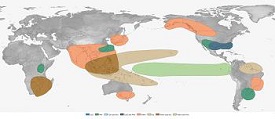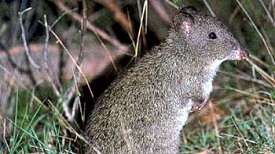
- Foreign Affairs
- International
- National
- Regional
- Defence
- Environment
- Science & Technology
- Banking, Finance, and Business
- Reports
- Appointments
- Awards
- Persons in NEWS
- Books & Authors
- Deaths
- Places in NEWS
- Sports
- Important Days
- Miscellaneous
- February 2019 - Exams Resources
- Current Affairs - Quiz
- Current Affairs - Test
- Current Affairs - PDF
Current Affairs Feb 2019 - Environment
1 - El Nio Likely to Increase Temperature in 2019

As per the UNs World Meteorological Organization report, 2019 may evidence the advent of El Nino resulting in a raise in temperature. El Nino, which is a natural phenomenon occurs once in every few years in the region of Eastern Pacific Ocean, but affects the whole world.
Last time, El Nio occurred in 2016 and made the year hottest ever recorded. El Nio has a great influence on weather around the globe, as it causes draught in some regions (such as parts of Australia) and floods in drier regions (such as in South America). In addition to this, the high temperature also affects the coral reef, as it causes bleaching on coral reefs.
2 - Centre Approved INR 59 Crore to Gujarats Gir Forest for Asiatic Lion Conservation

For the conservation of Asiatic Lion at Gir Forest in Gujarat, the Ministry of Environment, Forest and Climate Change (MoEFCC), has allocated 59 Cr. INR. Asiatic lion is one of the endangered species for which, the Ministry of Environment has launched a three-year Asiatic Lion Conservation Project. Ministry of Environment has collaborated with the state of Gujarat.
Asiatic lion is the last habitat of the big cat. To execute the program properly for the conservation and protection efforts of the Great Gir Region, the modern information and communication technology will be used.
It will include:
GPS-based animal and vehicle tracking,
automated sensor grid with movement sensors,
night vision capability,
real-time monitoring, and
report generation.
3 - To Monitor Cloud Activities, Observatory Set Up in Tehri

To Monitor cloud burst incidents in the Himalayan region and also to receive forecast, a Himalayan Cloud Observatory has been set up. The Observatory is set up in Tehri District of Uttarakhand state.
The cloudburst incidents are common and frequent in the Himalayan region of Uttarakhand, which cause huge loss of life and wealth more often. This observatory will help minimize the damage in the region. This is the second observatory in India to monitor cloudburst activities. It is set up and regulated by the Indian Science and Technology Department and Indian Institute of Technology (IIT) Kanpur.
4 - A Crying Snake Discovered in Arunachal Pradesh

A team of zoologists has discovered a new species of crying snake in Lepa-Rada district of Arunachal Pradesh. It is non-venomous crying keelback snake. Its zoological name is Hebius lacrima. Lacrima is a Latin term, which means tear.
So, the name of this keelback was given because of a dark spot under its eyes, which looks like a black tear. The dark spot interrupts a white stripe running along the upper jaw to the back of its head and beyond. The snake forms its habitat along the water areas of paddy fields, as it gets food. Its major food includes tadpole, small fish, small frogs, and geckos.
5 - An Australian Rat Became First Mammal to Extinct Due to Climate Change

The Australian Government has officially announced that the Bramble Cay Melomys is extinct because of the climate change. This species is a native of sand island near the coast of Papua New Guinea.
The small rat-like animal was missing since 2009; however, scientists first time guess that the animal might have become extinct in 2014. As per the report given by the University of Queensland and the Queensland government, there is no trace of this animal. They said that their team have made great effort to search this animal through 900 small mammal trap-nights, 60 camera trap-nights and two hours of active daytime searches produced no records of the species.
The reason of extinction is given climate change (especially human made climate change). Since, the animal had coastal habitat, extreme high water levels and strong storm surges could have destroyed their habitat.
6 - World Largest Bee Discovered in Indonesia

A group of researchers have discovered the worlds largest bee in Indonesia. The size of this bee is as large as the thumb of a human being. Since 1981, it was believed that it was extinct.
As per the CNN report, the entomologist Eli Wyman, behavioural ecologist Simon Robson and ornithologist Glenn Chilton, natural history photographer Clay Bolt, in a field research work, have made the spectacular "rediscovery" of the elusive critter and took the first photos and video of a living Wallace's giant bee.